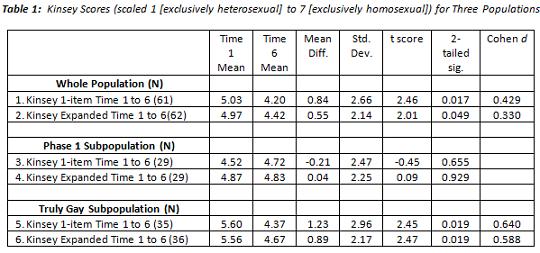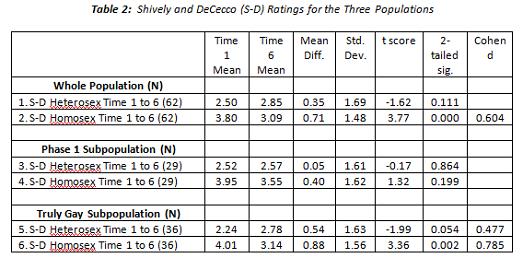This morning at the American Psychological Association annual convention, Stanton Jones and Mark Yarhouse are presenting their Time 6 and final follow up to the study of Exodus participants seeking change of orientation. The paper is titled, Ex Gays? An Extended Longitudinal Study of Attempted Religiously Mediated Change in Sexual Orientation. They are presenting these data as a part of a APA symposium titled Sexual Orientation and Faith Tradition Symposium chaired by Dean Byrd.
You can review the paper in full so I will only highlight a few points in the post.
The paper begins by recounting the skepticism toward change evinced by the professional mental health associations. Then, they note an important limit and hypotheses of the study:
Our study addresses the generic questions of whether sexual orientation is changeable, and whether the attempt is intrinsically harmful, by focusing only on the religiously mediated approaches to change; this is not a study of professional psychotherapy. Our hypotheses for this study were taken directly from the prevailing professional wisdom: We hypothesized 1) sexual orientation is not changeable, and 2) the attempt to change is likely harmful. We already cited the American Psychological Association’s (2005) claim that sexual orientation “is not changeable.” Regarding harm, our study was framed in light of the American Psychiatric Association’s (1998) claim that the “potential risks of ‘reparative therapy’ are great, including depression, anxiety and self-destructive behavior.” The tools of scientific study are ideally suited to investigate empirically such strong, even absolute claims.
I bolded the statement about the study not being an examination of psychotherapy because I predict that NARTH affiliated therapists and various religious conservative groups will not clearly communicate this point when messaging the results of this study. Despite the fact that Christian self-help groups are different than therapy as practiced by many psychodynamic therapists, I suspect some therapists will hope the public does not catch the distinction.
Now for some results. Retention is sure to be an issue as this study is discussed:
Retention. We began with 98 subjects at T1. Our sample eroded to 73 at T3, a retention rate of 74.5%. This retention rate compares favorably to that of respected longitudinal studies. 63 subjects were interviewed or categorized at T6, for a T1 to T6 6 to 7 year retention of 64%.
Kinsey scale changes:

This table shows the shifts in Kinsey scale scores (7 is exclusively homosexual with 1 being exclusively heterosexual). You can see that the shifts on average were about a point on the scale – less than one for the entire group and more than one for the group which were deemed more gay identified at the beginning. Although statistically significant, this would not on average take the group to the straight side of the continuum but rather by considered bisexual by most observers.
They also used the Shively-DeCecco scale which asks participants to rand both same-sex attraction and opposite-sex attraction. As you can see below, the change reflected in the Kinsey moves was due to reductions in SSA and not increases in OSA.

Regarding categorical self-assessments, Jones and Yarhouse report modest shifts.

Regarding these changes, Jones and Yarhouse say:
Several results are particularly notable. Despite a smaller N for the T6 sample than at T3, we found growth in absolute size in the two Exodus “success” outcome groups moving from row 1 to row 3: Conversion cases grew from 11 to 14 and Chastity cases from 17 to 18. But the group that grew the most in absolute and proportional terms was Failure: Gay Identity which doubled in absolute size from 6 to 12. The percentage of those showing stability of outcome T3 to T6 (row 4) is greatest in columns 1 and 6: the Success: Conversion (73%) and Failure: Gay Identity (67%) categories, with slightly less in the Success: Chastity category (53%). Of the one subject each that shifted from the Success: Conversion and Failure: Gay Identity categories from T3 to T6, each moved to the Continuing category at T6. The largest absolute shift from T3 to T6 of those who participated in the T6 interview was a T3 Success: Chastity case that became a Failure: Gay Identity case; next largest was a Non-Response case at T3 that became a Success: Conversion case.
Most germane to our principal hypothesis that change of sexual orientation is not possible, 53% of the T6 sample of 61 cases that self-categorized (row 3) did so as some version of success, either as Success: Conversion (23%) or Success: Chastity (30%). At T6, 25% of the sample self-categorized as an Exodus failure (Confused or Gay Identity).
In my view, this means of description confuses success with change. Over half did describe some version of success but that is not the same as over half describing sexual orientation change. I will be interested to see how this is reported in the press.
The changes reported here are significant and no doubt welcomed by the people involved. However, they are not the types of changes which I suspect the various mental health groups mean by “sexual orientation change.” Whatever happened to the participants in this study, they do not appear to have gone from gay to straight — in the sense that people who have always been straight are straight. They have gone from gay to less gay and a bit more straight. I do not mean to suggest that this is not important information; it is. But I am wondering if anyone at APA would dispute the within category changes reported here. I am going to ask and will report what I learn.
Jones and Yarhouse seem to be aware that the results can be understood as a change in identity and not orientation. They write:
There is also the question of sexual identity change versus sexual orientation change (see Worthington & Reynolds, 2009). Recent theoretical (e.g., Yarhouse, 2001) and empirical (e.g., Beckstead & Morrow, 2004; Yarhouse & Tan, 2004; Yarhouse, Tan & Pawlowski, 2005; Wolkomir, 2006) work on sexual identity among religious sexual minorities suggests that attributions and meaning are critical in the decision to integrate same-sex attractions into a gay identity or the decision to dis-identify with a gay identity and the persons and institutions that support a gay identity. In light of the role of attributions and meaning in sexual identity labeling, is it possible that some of what is reported in this study as change of orientation is more accurately understood as change in sexual identity?
The entire section on identity and orientation in the discussion section of the paper is good reading. Finally, in light of the APA task force report, I wonder if the discussion section of the Jones and Yarhouse paper could be revisited. The APA report, while skeptical of categorical change, did not take a strong stance regarding harm. Actually, the APA report and the Jones and Yarhouse paper agree on the inconclusive nature of the evidence on that question.


